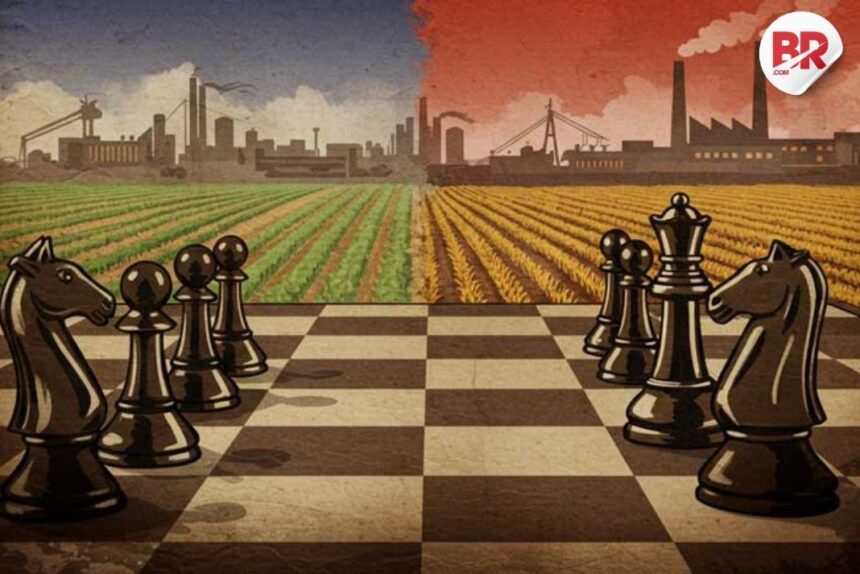
Welcome to the Board Game of Global Chaos
Brinks Report – Trade war explained in the simplest way?
Imagine a chaotic board game where world leaders play with tariffs, tweets, and tantrums.
There are no clear rules. No one agrees on how to win. And the dice? It’s heavily biased.
At the table sit major economies like the U.S., China, India, and the EU.
The goal?
“Win global trade.”
No one knows what that means.

Setting Up the Board
Each country starts with:
- A bunch of exports and imports
- Manufacturing power
- Natural resources
- A currency that stays calm… until someone makes a sudden announcement
Bonus tokens:
- Tariffs
- Sanctions
- Secret trade deals (usually with eyebrow-raising partners)
This is trade war explained as a game—and it’s anything but fun.
The U.S. Makes the First Move
America goes first. It has a strong economy, top tech brands, and energy independence.
It rolls a 5 and slaps tariffs on Chinese steel and aluminum.
“Take that!” they shout.
China responds with a Soybean Penalty.
Suddenly, U.S. farmers can’t export.
Iowa loses a turn.
Also Read: U.S. Tariffs on China Soar to 125%—Goldman Sachs Warns of Fallout as Global Markets React
China Strikes Back
China builds a fast track to Europe with its Belt and Road Initiative.
It rolls a 7 and plays the Rare Earth Trap Card.
Now, U.S. companies can’t access critical minerals for smartphones and batteries.
It’s like Monopoly—but with bulldozers and debt.
They also offer loans to countries in Africa and Asia, expanding influence silently.
EU Wanders Through the Game
The EU splits its turn between Germany and France.
They’re not on the same page.
They roll a 3 and retaliate with tariffs on peanut butter and motorcycles.
The UK keeps popping in asking,
“Can I play again? Just for one turn?”
Nobody responds.
India Watches—and Plans
India doesn’t fight first. It places bets on semiconductors, solar energy, and partnerships with the Global South.
Rolls a 6.
Gets bonus points for hosting a big G20 summit—lots of smiling pictures, no clear outcomes.
India is playing the long game.
Also Read: US-China Tech War: Why AI and Chips Are the Real Conflict Now
Special Game Cards You Might See
- Currency Manipulation! (Switch inflation stats with another player)
- Supply Chain Breakdown! (Lose two turns and most of your microchips)
- AI Disruption! (Everyone panics. No one knows what to do.)
- Pandemic Panic! (Remember that round? Nobody won.)
Trade War Explained by the Messy Scoreboard
No one is sure who’s winning.
GDP goes up, then down.
Markets rise on bad news and fall on hope.
Consumers pay more.
Deals are made—then broken with a single social media post.
That’s trade war explained in real time.
What This Game Teaches Us
Trade wars are not real wars.
They’re slow, confusing, and full of economic own-goals.
There are no true winners.
Everyone loses money, jobs, and peace of mind.
Tariffs aren’t clever strategies.
They are just price hikes with patriotic wrapping.
In the end, global trade is not a zero-sum game.
When you try to “win” by hurting others, you often damage yourself.
Final Takeaways From the Trade War Game
- Tariffs = pain for everyone
- Cooperation > confrontation
- Trade strategy needs calm minds—not midnight rants
Because in this game, if you play dirty too long…
someone flips the table.
⚠️ Disclaimer:
This article is a satirical and simplified take on complex global economic dynamics. While it uses humor and fictional game elements to explain trade wars, it is not intended as financial advice or a comprehensive policy analysis.
Also Read: The Dragon Bites Back: China Unleashes Economic Counterstrike on U.S












